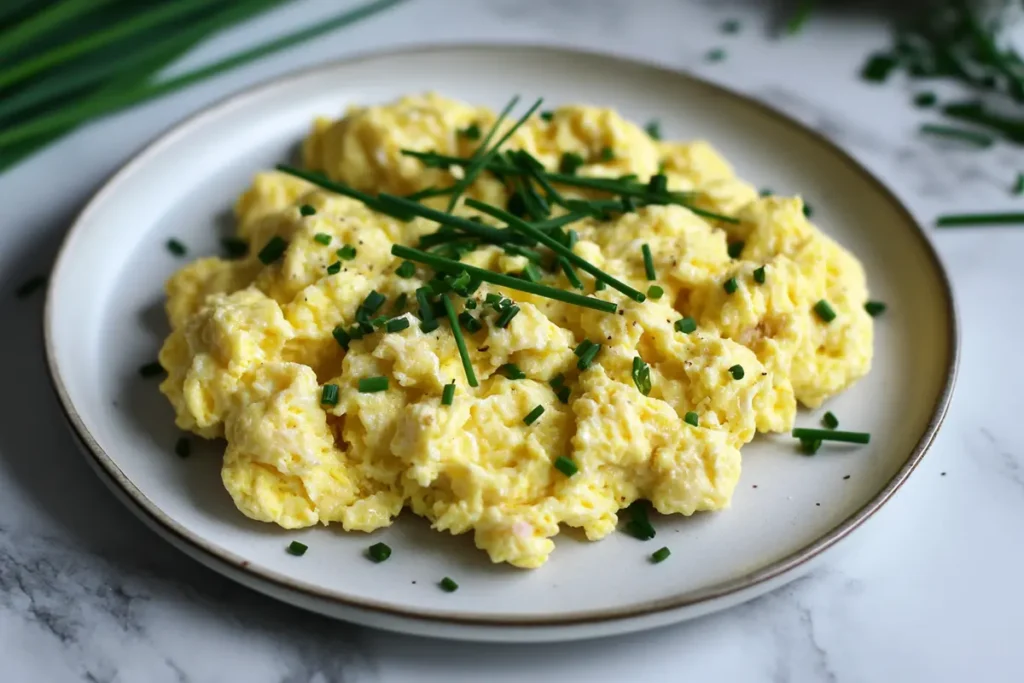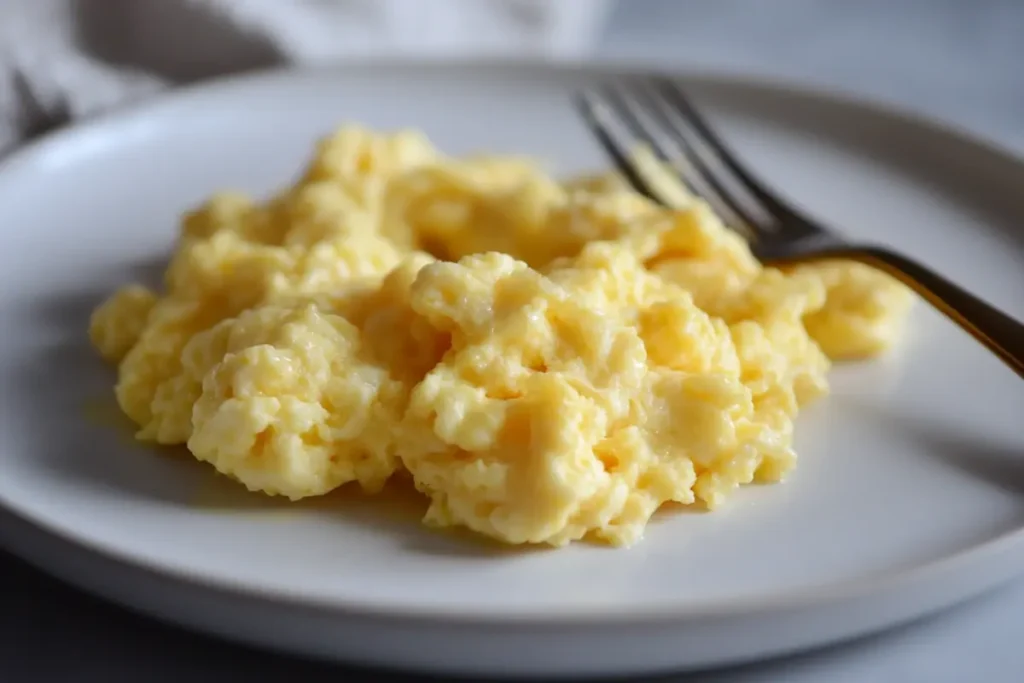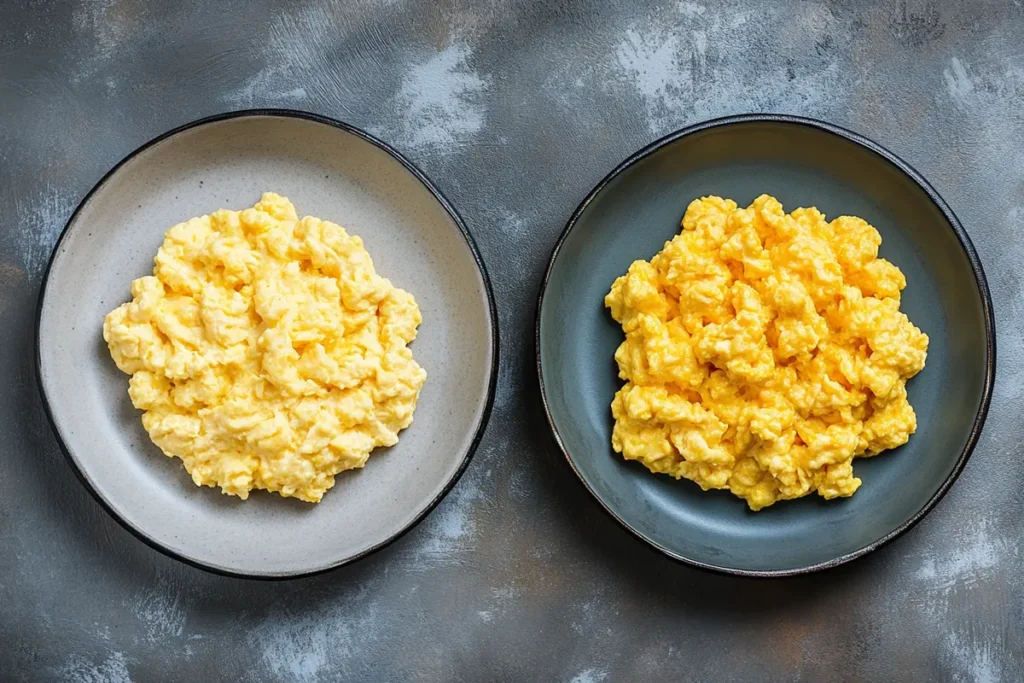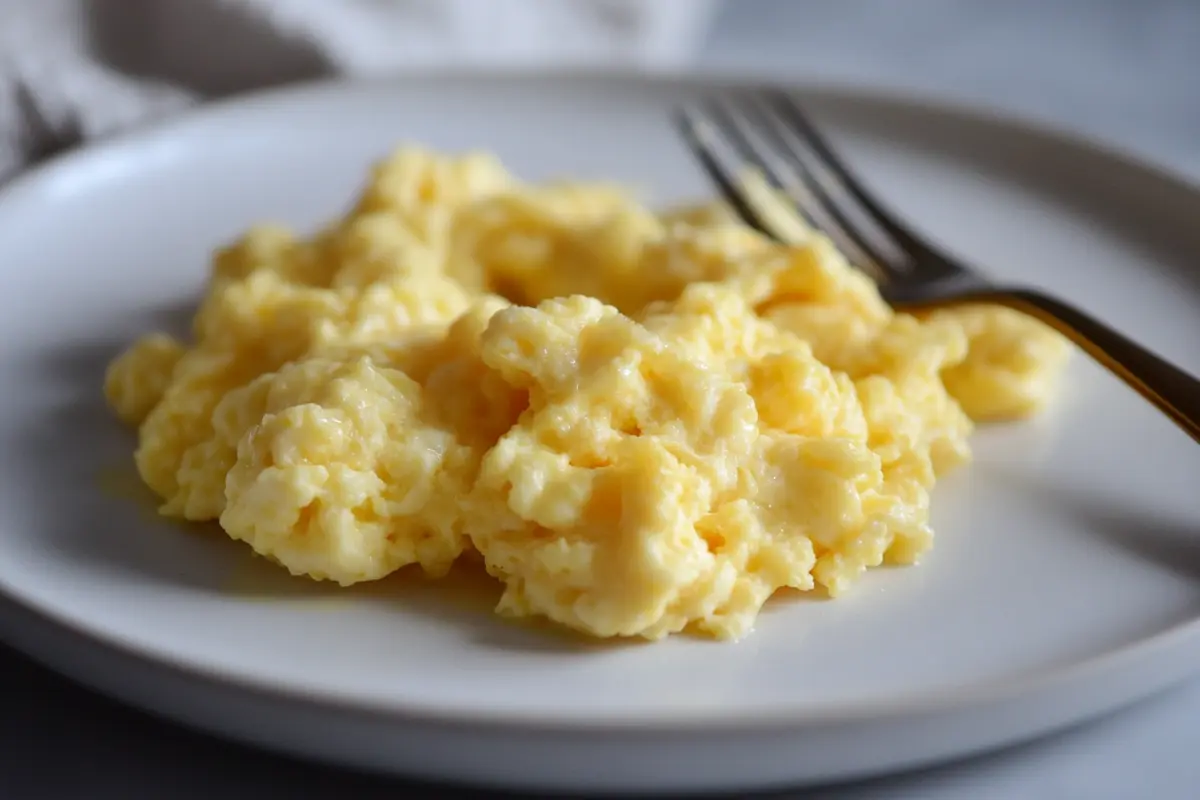The quest for perfectly scrambled eggs is a common culinary pursuit. What’s the best temperature to scramble eggs? This is the key question that often determines the texture and taste of this simple yet crucial breakfast staple. Getting the temperature right can transform your eggs from rubbery and dry to wonderfully creamy and soft. Therefore, understanding the science behind cooking eggs and heat control is essential for any home cook.
Why Temperature Matters When Scrambling Eggs
So, why is the temperature so crucial when it comes to scrambling eggs? First, it directly affects the texture. Low heat allows the eggs to cook slowly and gently. This will create small, delicate curds, which are typically favored for their creamy texture. Conversely, high heat causes the proteins in the eggs to coagulate rapidly. This will force out moisture and creates large, rubbery curds that are not as palatable. Therefore, the temperature is the main factor in achieving that perfect texture.
Secondly, temperature control is vital for avoiding overcooked eggs. Overcooked eggs are dry and tasteless. Therefore, it’s essential to monitor the heat and cooking time. The goal is to cook the eggs until they are just set. They should have a moist and tender consistency. In addition, the right temperature prevents the eggs from browning or burning on the bottom of the pan. This is particularly important for stovetop cooking, where hotspots can easily develop.
Finally, the cooking temperature impacts the overall cooking time. Cooking at a low temperature will take longer. However, it gives you more control. Conversely, high heat will cook the eggs faster. However, you’ll have a much smaller window between perfect and overcooked. Thus, temperature is not just about the texture. It’s also about control and consistency. The right temperature allows for a balanced cook, resulting in eggs that are perfectly set and incredibly delicious.
The Ideal Temperature Range for Scrambling Eggs
So, what’s the best temperature to scramble eggs? The ideal temperature is low to medium-low heat. This translates to about 250°F to 300°F (120°C to 150°C) on a stovetop. This range allows for gentle cooking, ensuring the eggs cook slowly and evenly. Using low heat prevents the proteins from seizing up too quickly. It also creates a creamy, tender texture that many find preferable. However, the type of pan and the stovetop will affect the temperature.
It’s essential to adjust the heat based on your specific stovetop and pan. Some stoves can run hotter than others, so you might need to dial back the heat a bit. Also, the material of the pan makes a difference. For example, a thin pan will heat up very quickly. Therefore, you’ll need to keep the heat low. However, a heavy-bottomed pan will distribute heat more evenly. This allows you to use slightly higher heat if needed. In addition, using a non-stick pan is extremely helpful. It prevents the eggs from sticking and burning.
- Ideal Temperature: 250°F to 300°F (120°C to 150°C)
- Adjust based on stovetop and pan type.
- Use low to medium-low heat.
- Use a non-stick pan.
Step-by-Step Guide to Scrambling Eggs at the Right Temperature
Now that you understand the importance of temperature, let’s walk through the step-by-step process. First, begin by prepping your pan. Place a non-stick pan over low to medium-low heat. Add a small amount of butter or oil. The fat helps prevent sticking and adds flavor. For example, using butter creates a rich flavor, while oil can be used as a healthier alternative. Let the fat melt and spread evenly across the pan’s surface.
Next, whisk your eggs in a bowl with a splash of milk or cream. Season with salt and pepper to taste. Whisk until the yolks and whites are fully combined. Don’t over-whisk. Otherwise, it could result in tougher eggs. Once your pan is hot and your eggs are whisked, pour the mixture into the pan. Allow it to cook undisturbed for a few seconds. This will let the bottom layer begin to set.
As the eggs start to set, use a spatula to gently push the cooked edges towards the center. Tilt the pan to allow the uncooked egg to flow underneath. Therefore, you are gently moving the cooked portions aside to allow the uncooked eggs to set evenly. Continue this process until the eggs are mostly set but still slightly moist. Finally, remove the pan from the heat, and gently fold the eggs a couple more times. They will continue to cook from the residual heat. Serve immediately and enjoy your perfectly scrambled eggs.
- Heat a non-stick pan over low to medium-low heat.
- Add butter or oil to the pan.
- Whisk eggs, milk/cream, salt, and pepper.
- Pour egg mixture into the pan.
- Let the eggs set for a few seconds.
- Gently push the cooked edges towards the center.
- Remove from heat when mostly set.
- Fold eggs a couple more times.
- Serve immediately.

Tips for Maintaining the Right Temperature
While knowing the best temperature to scramble eggs is important, maintaining that temperature is equally crucial. First, use a heavy-bottomed pan if you can. These pans distribute heat more evenly, preventing hot spots that can overcook some areas while leaving others undercooked. Therefore, a quality pan is a valuable tool for any kitchen. Secondly, pay close attention to the heat setting. Don’t set it and forget it. Adjust it as needed to keep the temperature consistent.
In addition, avoid overcrowding the pan. If you have too many eggs in the pan at once, it can be difficult to manage and maintain an even cooking temperature. Therefore, it’s better to cook the eggs in batches if you’re making a larger quantity. Monitor the pan temperature by touch. If the pan feels too hot, reduce the heat. If it seems too cool, you might want to increase it slightly. Finally, practice makes perfect. As you become more familiar with your stovetop and pan, you’ll get a feel for the ideal temperature. This will become second nature.
- Use a heavy-bottomed pan for even heat.
- Adjust heat as needed.
- Avoid overcrowding the pan.
- Monitor pan temperature by touch.
- Practice makes perfect.
Troubleshooting Common Temperature-Related Issues
Even with the best practices, sometimes you may still run into issues when scrambling eggs. Therefore, let’s troubleshoot common temperature-related problems. First, if your eggs are dry and rubbery, it likely means the heat was too high. The eggs cooked too quickly, forcing out the moisture. Therefore, next time, use a lower temperature. Secondly, if your eggs are watery, this could mean the temperature was too low. The eggs didn’t set properly. However, it can also mean that the pan isn’t hot enough before you add the eggs.
If your eggs stick to the pan, the pan may not be hot enough. However, it can also mean the pan is not non-stick, or the fat was not spread adequately. Next time, use a non-stick pan and add fat evenly. In addition, if the edges of the eggs are overcooked while the center is still runny, the temperature might be uneven. Therefore, try using a lower heat, and ensure your pan distributes the heat evenly. Always adjust heat as needed, and try to get your heat setting just right.
- Dry and rubbery eggs: Heat was too high.
- Watery eggs: Heat was too low, or the pan was too cold before you added the eggs.
- Eggs sticking to the pan: Pan wasn’t hot enough or not non-stick.
- Unevenly cooked eggs: Heat is not evenly distributed, or pan is not of good quality
Variations in Egg Scrambling Techniques Based on Temperature
The best temperature to scramble eggs is generally low to medium-low. However, different culinary techniques may use slightly varying temperatures. For instance, some chefs prefer a very low heat, almost off the heat, for a super creamy, almost custard-like texture. This involves frequently removing the pan from the heat and gently stirring the eggs. This low and slow method is excellent for delicate curds, but it takes more patience and time.
On the other hand, some people prefer a slightly higher medium heat for quicker cooking. This method will create firmer curds. However, it also increases the risk of overcooking if you are not careful. In addition, the type of fat used can also influence the temperature and technique. For example, butter has a lower smoke point than oil. Therefore, it requires more gentle heat. Ultimately, the preferred method comes down to personal preference. However, low and slow is the method used by most professionals for a creamy and soft result.
- Very low heat: Super creamy, custard-like texture.
- Medium heat: Firmer curds, quicker cooking.
- Adjust based on personal preference.
- Consider the smoke point of the fat you are using.

The Role of Ingredients in Egg Scrambling Temperature
While temperature is the key factor when scrambling eggs, the ingredients can also have an impact on the ideal cooking process. For example, if you add milk or cream to your eggs, it increases the moisture content. Therefore, it’ll slightly slow down the cooking time. You might also need a slightly lower temperature to prevent the eggs from becoming watery or overcooked. Similarly, adding cheese or other mix-ins can alter the heat distribution. Therefore, it’s important to adjust accordingly.
In addition, some people prefer to add salt to their eggs just before cooking. However, if you do this too far in advance, the salt can draw out the moisture from the eggs and affect the texture. Therefore, add the salt just before cooking or right at the end. The type of pan you are using will also have an effect. A thin pan will heat very quickly and unevenly. However, a thicker pan will distribute the heat more evenly. Therefore, the right pan will play an important role. The moisture content of eggs will also vary depending on where you source your eggs.
- Milk/cream: Slows cooking, use slightly lower heat.
- Cheese/mix-ins: May alter heat distribution.
- Salt: Add just before cooking to avoid moisture loss.
- Pan type: Impacts heat distribution.
- Egg moisture content: Can affect cooking time
Common Myths About Scrambling Egg Temperature
There are several myths about what’s the best temperature to scramble eggs and cooking them, and it’s important to address these. First, many people believe that high heat is necessary to achieve fluffy eggs. However, this is not the case. High heat cooks the eggs too quickly, forcing out moisture and creating a tough, rubbery texture. Therefore, low to medium-low heat is better for fluffy results. Secondly, some think that whisking eggs for a long time will make them fluffier. However, over-whisking can lead to tougher eggs.
Another myth is that you should leave eggs undisturbed in the pan until fully cooked. However, gentle and constant movement is key to even cooking and preventing sticking. In addition, some people believe that adding milk or cream makes the eggs more watery. However, these additions add richness and moisture as long as you’re cooking at the correct temperature and time. Therefore, knowing the truth is key to a good result. Finally, some say that a cold pan is best for scrambling eggs, this is not true. The pan must be hot before adding the eggs to avoid sticking.
- Myth: High heat makes eggs fluffy.
- Myth: Whisking eggs for a long time makes them fluffier.
- Myth: Leave eggs undisturbed in the pan.
- Myth: Milk/cream make eggs watery.
- Myth: A cold pan is best for scrambling eggs.
Serving and Enjoying Perfectly Scrambled Eggs
Once you’ve mastered the best temperature to scramble eggs, it’s time to enjoy your creation. First, serve your eggs immediately after cooking. They are best when they are fresh and still moist. Therefore, don’t let them sit too long. Secondly, consider pairing them with other breakfast favorites. Toast, bacon, sausage, and fresh fruit are excellent options. These will complete a balanced and satisfying meal.
In addition, scrambled eggs are incredibly versatile. They can be used as a filling for breakfast sandwiches or burritos. You can also enjoy them on top of a slice of avocado toast. Further, you can add various toppings, such as hot sauce, salsa, or fresh herbs. These will enhance the flavor. Furthermore, consider adding other mix-ins to your scrambled eggs. Cheese, vegetables, or cooked meats are good additions. These will add flavor and texture. Finally, remember that a little bit of seasoning can go a long way. Therefore, don’t be afraid to experiment with different spices to find what you like.
- Serve immediately after cooking.
- Pair with toast, bacon, sausage, and fruit.
- Use as a filling for sandwiches or burritos.
- Add toppings and mix-ins for extra flavor.
- Experiment with different seasonings.

Frequently Asked Questions About Scrambling Egg Temperature
Here are some frequently asked questions related to what’s the best temperature to scramble eggs:
Do you cook scrambled eggs on medium or high?
Generally, you should not cook scrambled eggs on high heat. Cooking them on high heat is a common mistake, which can lead to dry, tough, and rubbery eggs. The proteins in the eggs coagulate too rapidly at high temperatures. Therefore, they will squeeze out the moisture and create large, undesirable curds. It is far better to cook them over medium-low heat. Low to medium-low heat (around 250°F to 300°F or 120°C to 150°C) is ideal for gently cooking the eggs. This low temperature allows the eggs to cook slowly. This results in smaller, softer curds and a much creamier texture.
Should you cook eggs on low or high heat?
For scrambled eggs, it is generally recommended to cook them on low to medium-low heat rather than high heat. High heat will cause eggs to cook too quickly. This will produce a dry, rubbery texture. It is better to cook them at lower temperatures. This allows them to cook gently. Low heat will also allow you to control the texture of the eggs. Therefore, stick to low or medium-low. Low to medium-low heat is the best option for most scrambled egg recipes. However, cooking eggs over low heat takes a little more time. This method results in the creamiest and most tender result. Therefore, it is worth the patience.
What is the chef’s secret to the best scrambled eggs?
Many chefs have their unique approach. However, most agree on a few key principles for making the best scrambled eggs. First, they emphasize low and slow cooking. Therefore, they cook eggs over low to medium-low heat. This helps to create a creamy and soft texture. In addition, they will gently stir or fold the eggs during cooking. They will not let them cook untouched. This ensures that all parts of the eggs cook evenly.

